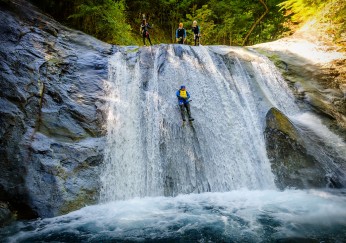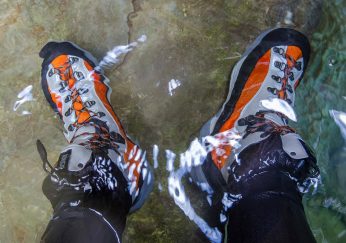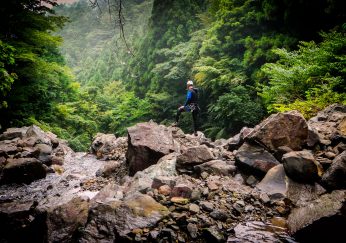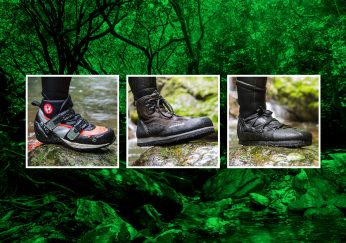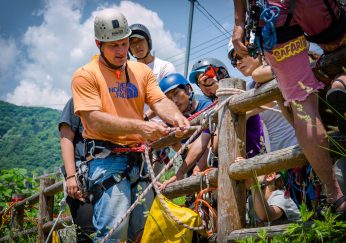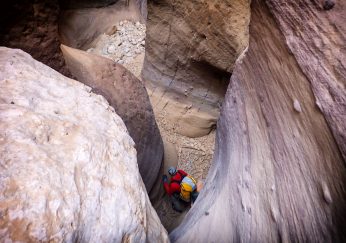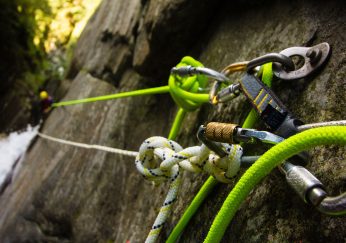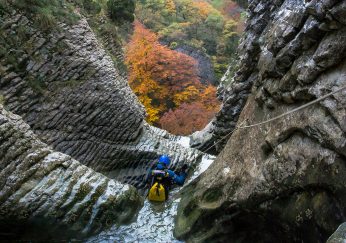With each step, the pack cut deeper into my hips. It was only the first hour of our 8-day Malishan canyon exploration. How the hell am I going to make it? Our Rodcle 55L bags were overflowing with everything we’d need. Mine weighed in at a cool 33 kgs (72 lbs), and it wasn’t even the heaviest in the group. Moritz Sonntag, the expedition’s filmmaker, was miraculously carrying two bags. What a machine.
The Taiwan Canyoning Expedition had been a project in the making for several years. The country’s potential first came to our radar in 2013 when Akira Tanaka brought in a Japanese magazine with pictures of a recent Sawanobori expedition up Qia Kan, Taiwan’s largest canyon. The images were captivating with white marble, blue pools, and incredible commitment. The Sawanobori climbers were perched perilously on the huge canyon walls trying to skirt the A7 water flow below. They looked like ants compared to the canyon features. Little did we know, these same climbers would later become a part of the Taiwan Canyoning Expedition.
The first full canyoning descent of Qia Kan was the original objective of the Taiwan Canyoning Expedition. At a whopping 14 days, it would have been the biggest canyoning conquest in human history. But the weather gods didn’t favour us, and a huge storm system laid over the northern part of the island. Water gauges indicated the Qia Kan was meters higher than when the Sawanobori climbed it in 2013. It barely looked passable from their pictures then, with so much more water now, we’d likely be writing our own obituary. The team needed another plan, and it looked like the southern part of Taiwan might miss the rain.
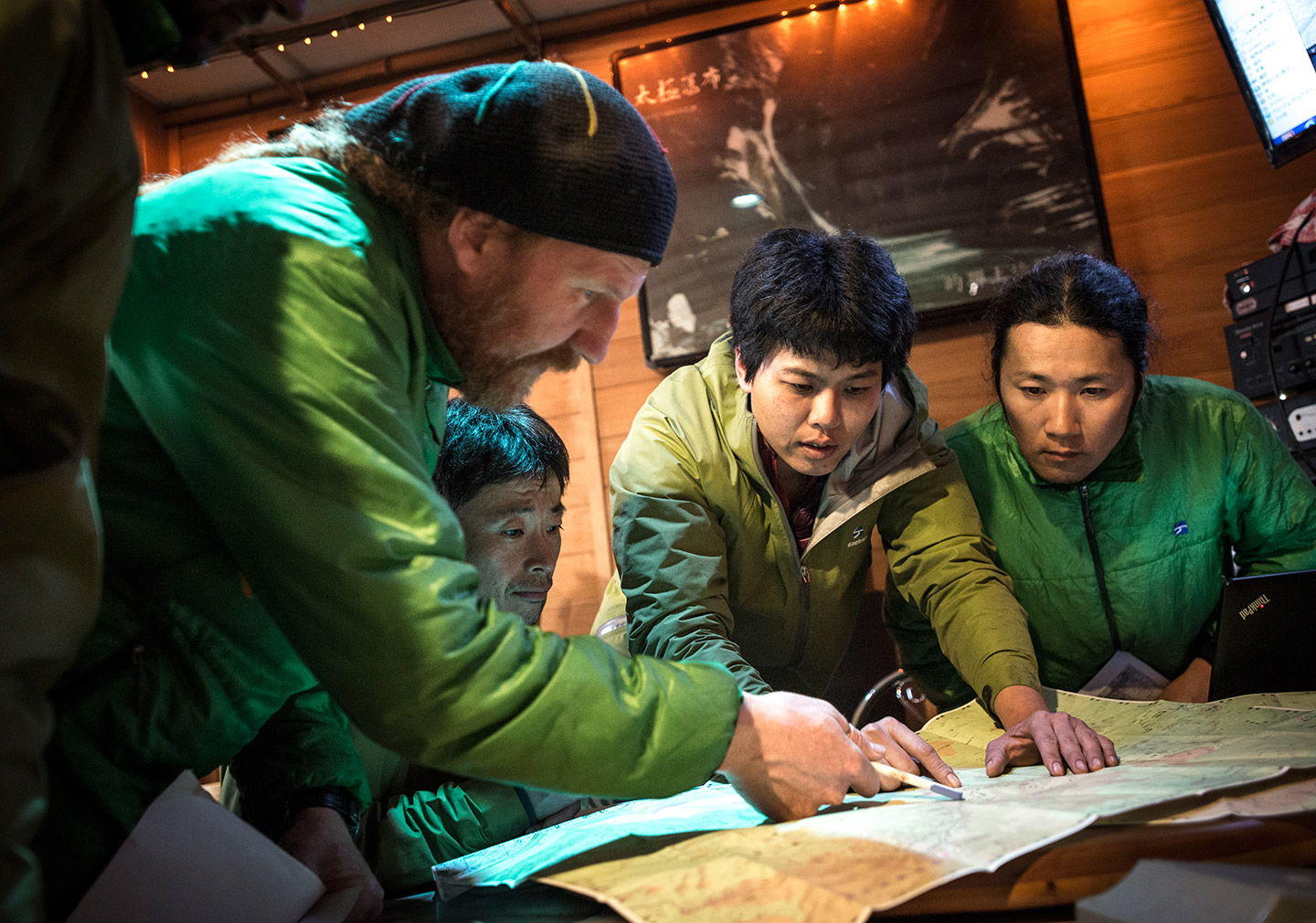
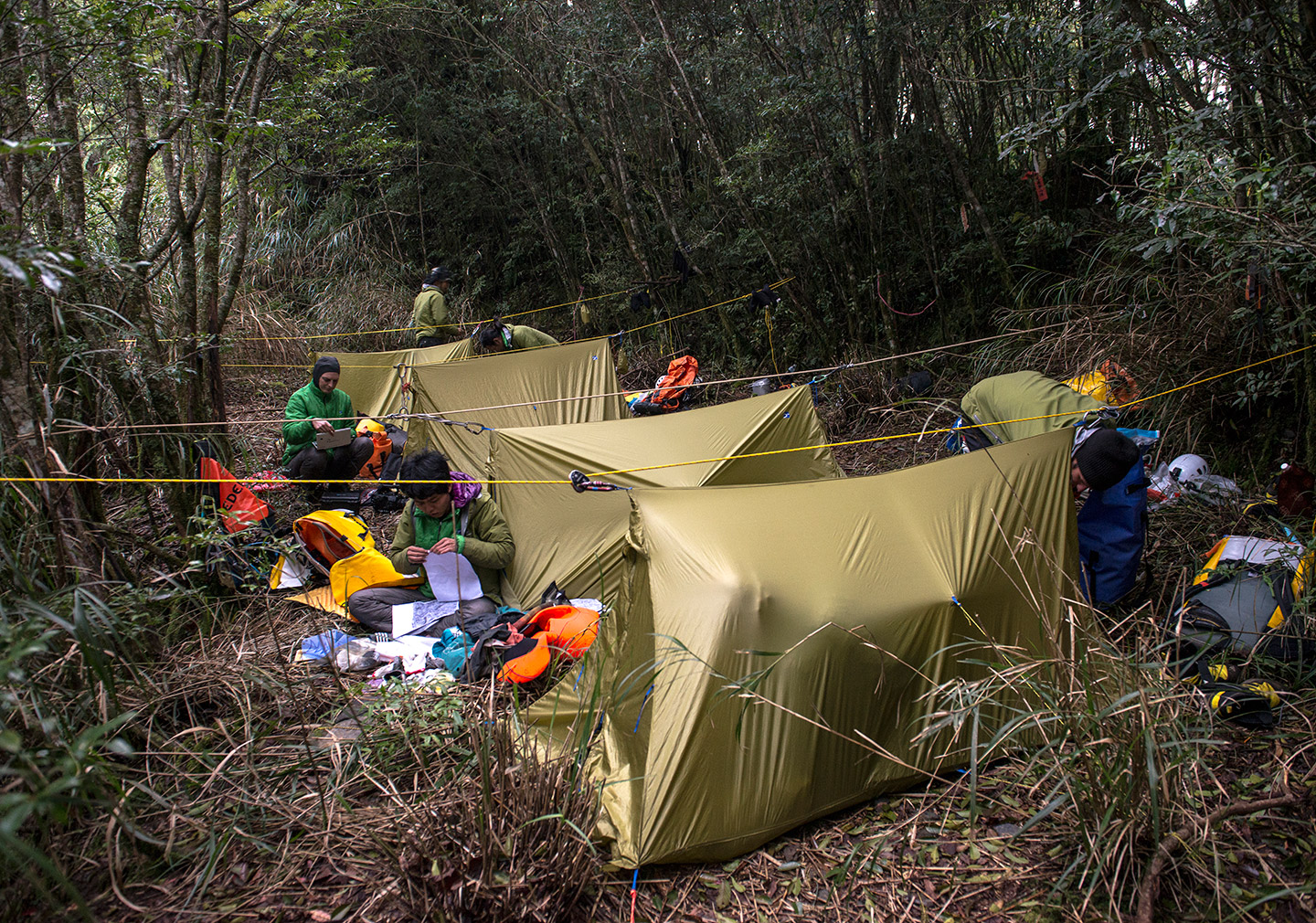

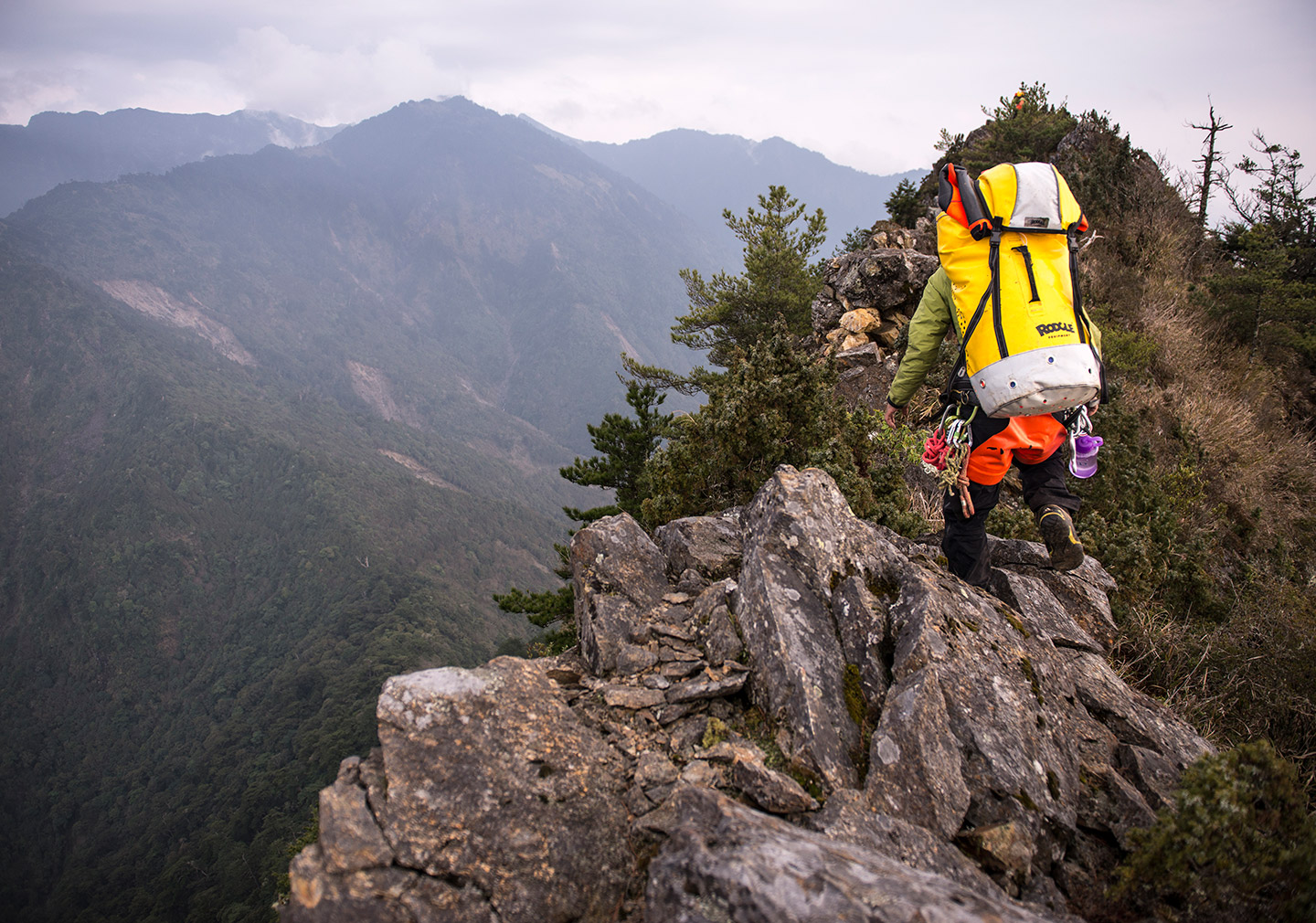
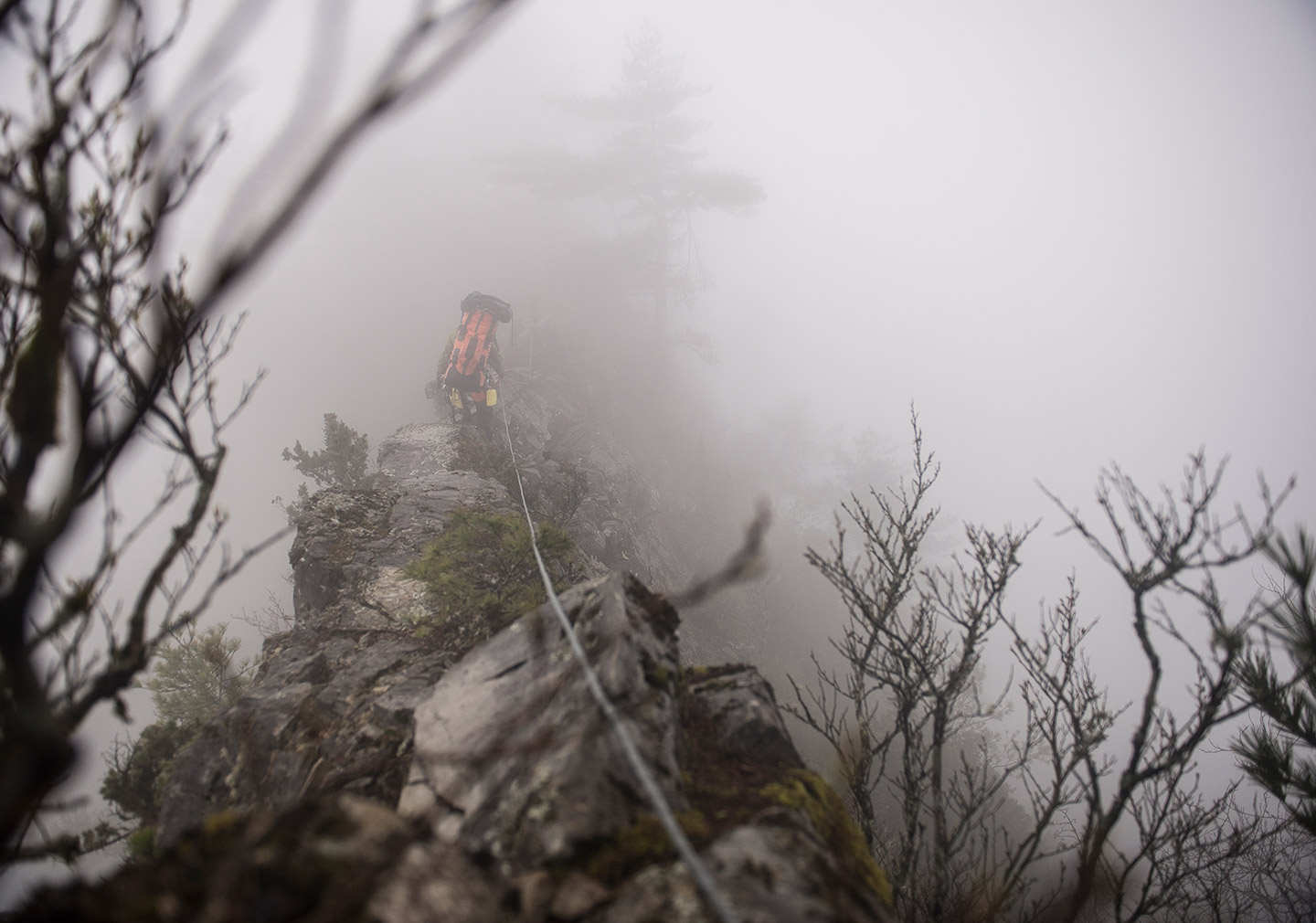
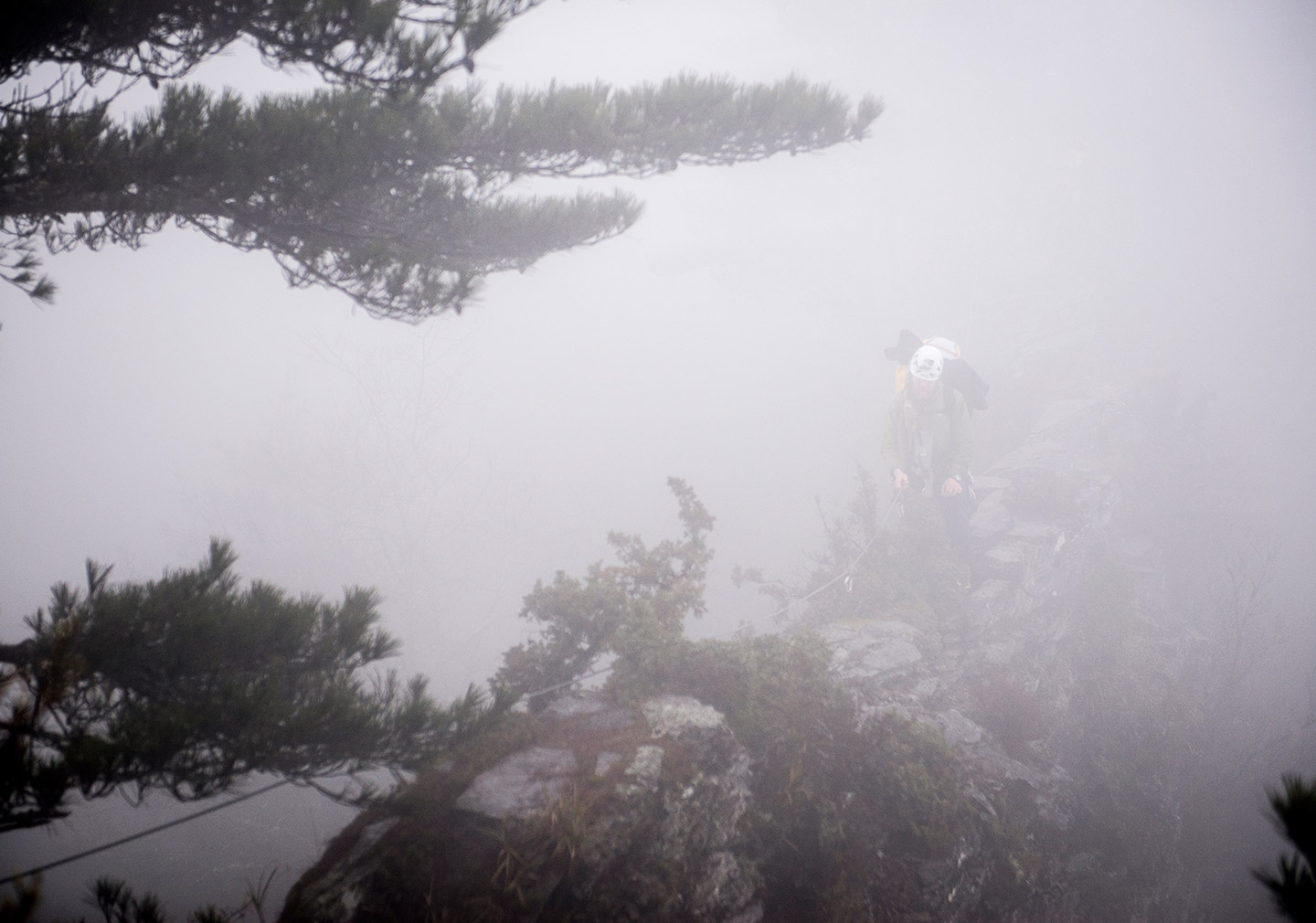
Only 2 months prior, a magnitude 6.4 earthquake had struck the Kaohsiung district in southern Taiwan. The earthquake caused massive widespread damage, and it killed 114 people. The Malishan canyon, our new objective, was less than 50km from this earthquake’s epicentre. The quake’s damage to the area was obvious; countless landslides speckled the mountain sides. We knew the approach to the canyon would be no easy feat. Boy was that an understatement.
Well fuck. I was standing at the edge of the 4th rock spire looking down a sheer cliff that disappeared into the clouds below. We had just crossed a Tyrolean traverse to reach this spire, which we hoped would be the end of this 2 day epic. Last night we were forced into an emergency bivvy on top of the 3000m 2nd spire. The earthquake aftershocks gently shook us to sleep on the rocky outcrop during the night. Sticking to the ridgeline to avoid landslides no longer seemed like such a good idea. We might actually need a rescue to get off this thing.
Miraculously, we found a route down off the 4th spire, despite the map indicating a 500m bluff. After a good night’s sleep below tree line, we entered the canyon on Day 4. The day began with sunny skies and A4 water levels. The canyon quickly narrowed and the terrain steepened. The team snapped into a groove, and we were making a swift progression down. Then the progress stopped. The rock type changed, and our drill could barely penetrate the 200+ MPa rock. This wouldn’t have been such a problem if we weren’t at the steepest section where the canyon dropped 300 meters in a series of 5 waterfalls. Clouds rolled in, the temperature dropped, and it started to rain.
At 7:00pm with darkness setting in, I arrived at the top of the final 70m pitch to find Moritz standing on a 10cm ledge with his cowstails loose and his hands pulling vigorously upwards on the tensioned rappel rope below. He looked worried. I came down further to find the anchor was two marginal piton placements and it wasn’t equalized well. Moritz had discovered the same thing, and he was now trying to take weight off the anchor because it didn’t look like it would hold. Rainwater poured from every place alongside the cliff, and little rocks were being pulled down with it. I couldn’t have imagined a worse situation. At 51 kgs, Indonesian power-house Supii Liem offered to de-rig this pitch. I’ve never been so thankful. We’re going to have to get it together if we want to get through this canyon. Darkness forced another emergency bivvy.
Day 5 started with drops as far as the eye could see. The steepness was relentless, and we were already behind schedule. We needed to push hard to get through this section if we wanted to camp in an open area. We rigged quickly (and more safely) to navigate the terrain. Things were going better even though I almost killed Ryoji Onishi when I knocked loose a table sized rock on rappel. I didn’t know he could run so fast. More creeks entered the canyon, and our water flow increased to an A5 level. We were greeted by one of the coolest waterfalls I’ve ever seen: An 80m waterfall banked around a left-hand curve and barrel-rolled the water not once, but twice during its journey to the bottom. This is what it’s all about.
Unfortunately the delight of Day 5 didn’t last long. Night fell and we weren’t even close to the open area we sought for camp. We pushed until we found a small embankment that could hold us for the night, forcing yet another emergency bivvy. After all we had already been through, this was the night I questioned what we were doing. The embankment was formed by a recent rockslide above. House-sized schist plates clung precariously to the smooth rock slope, aiming directly at our camp if the slightest aftershock loosened them. The embankment was no higher that 30cm above the water, and we were far from safe if levels rose. Gus Schiavon summed up the night perfectly the next morning when he said, “I’m pretty sure I figured out every way in which we could have died last night.”
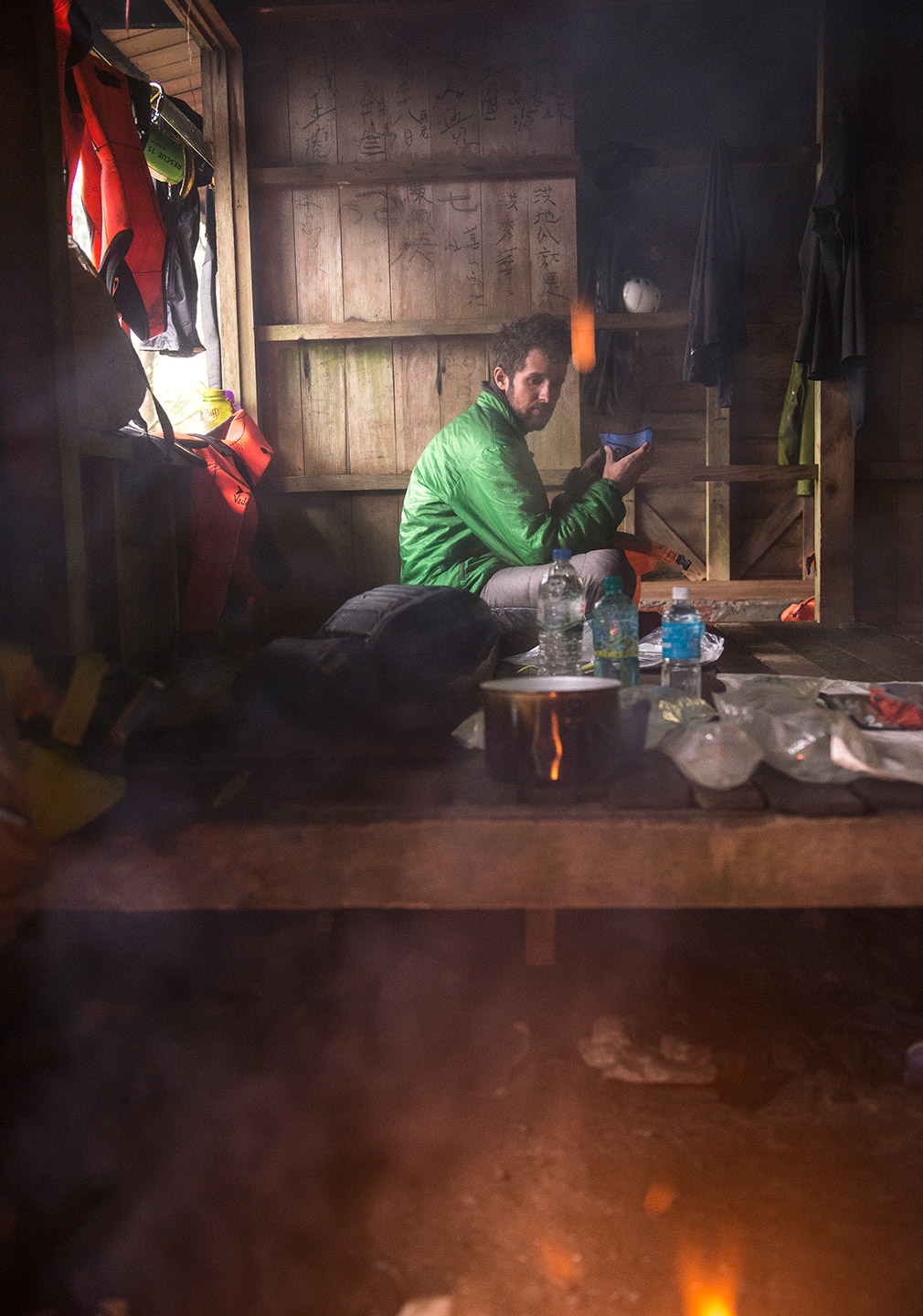
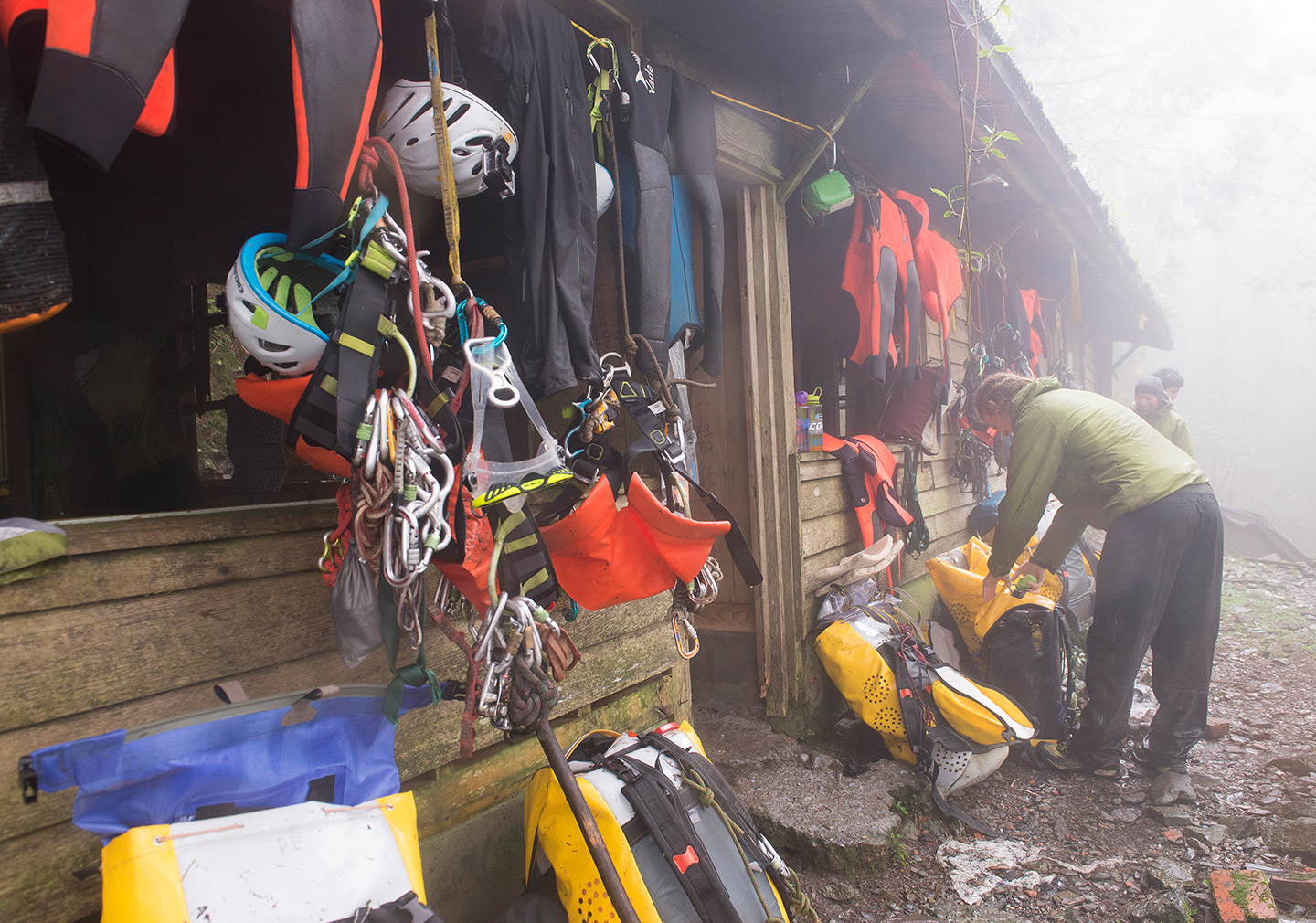
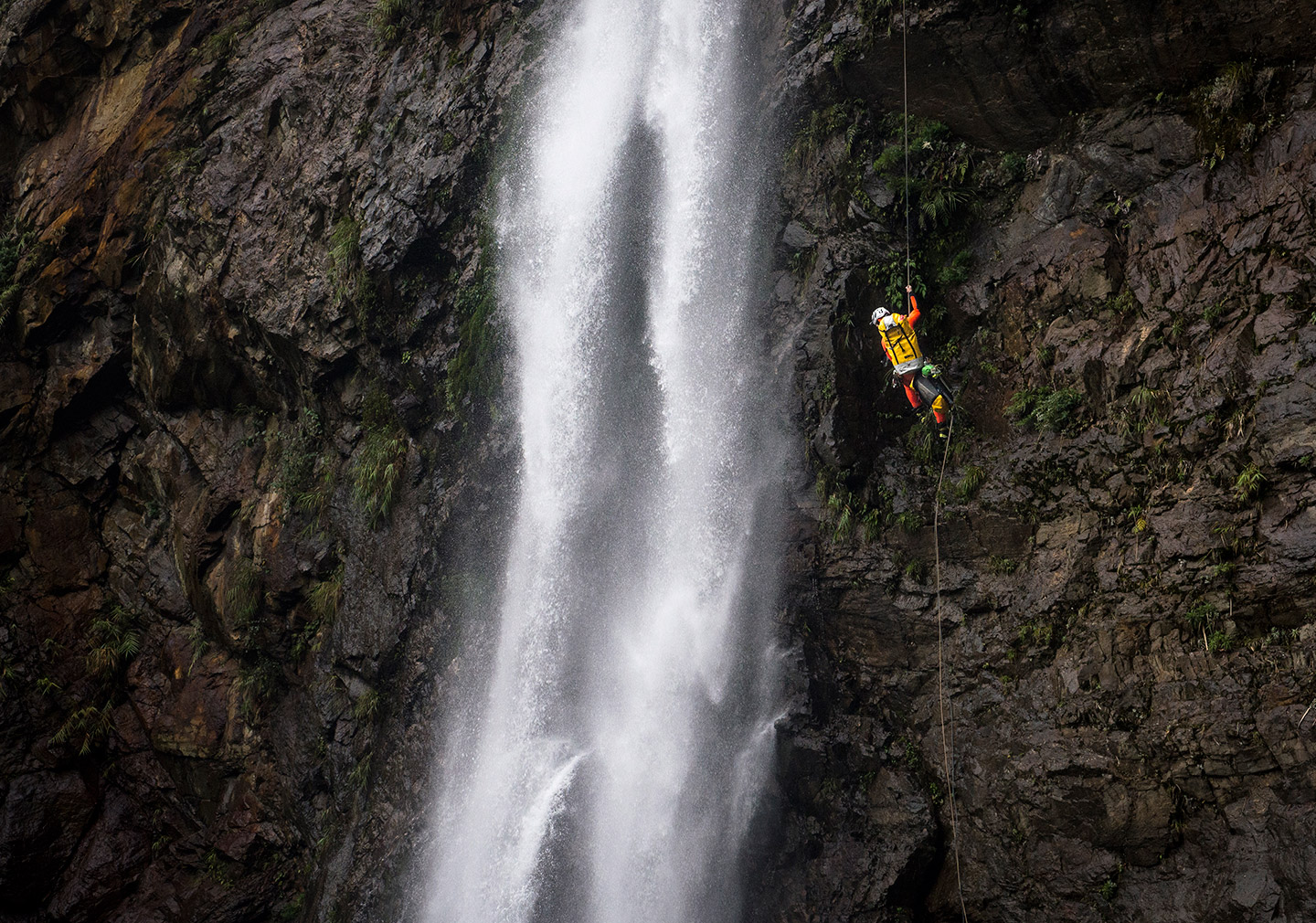
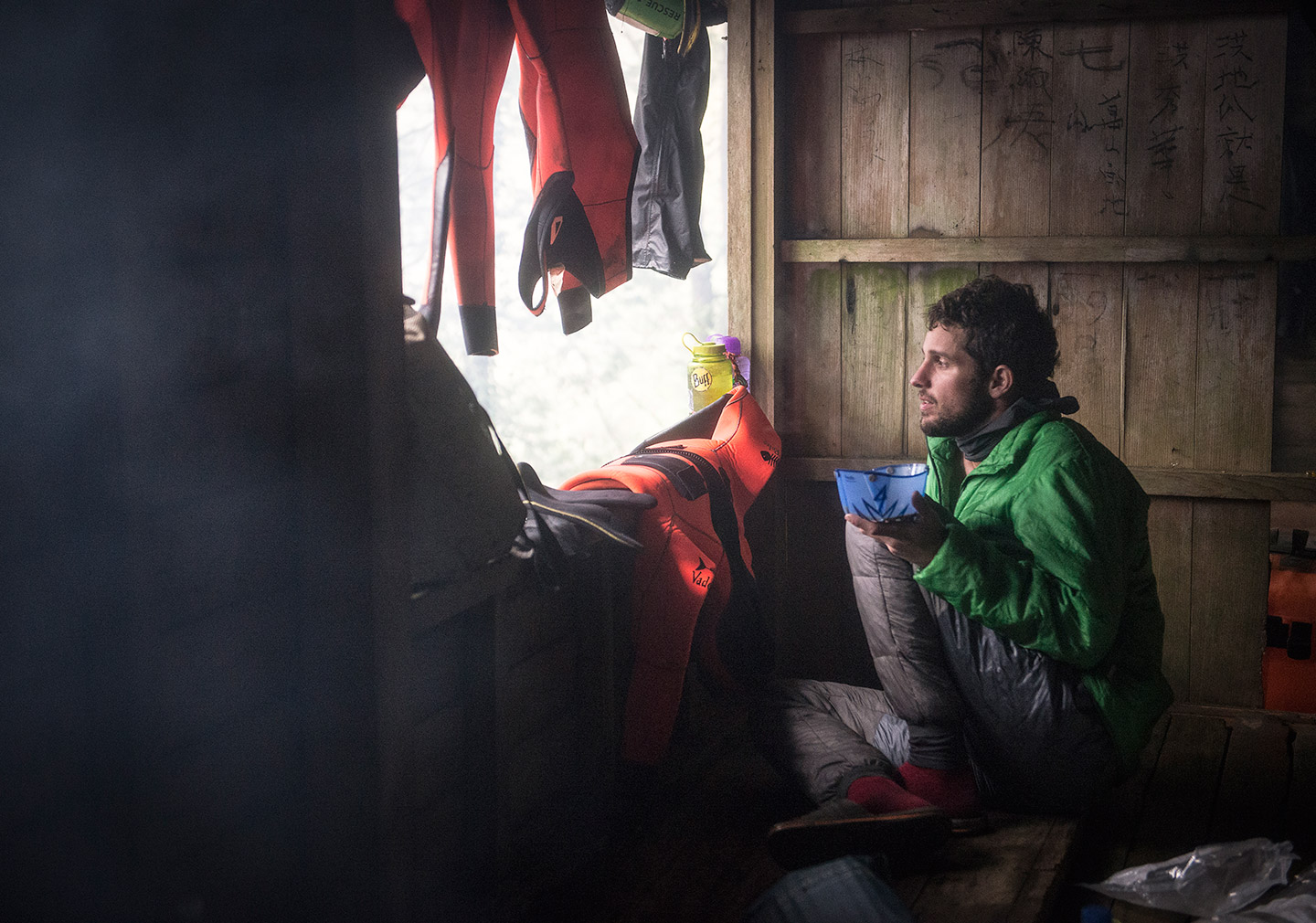
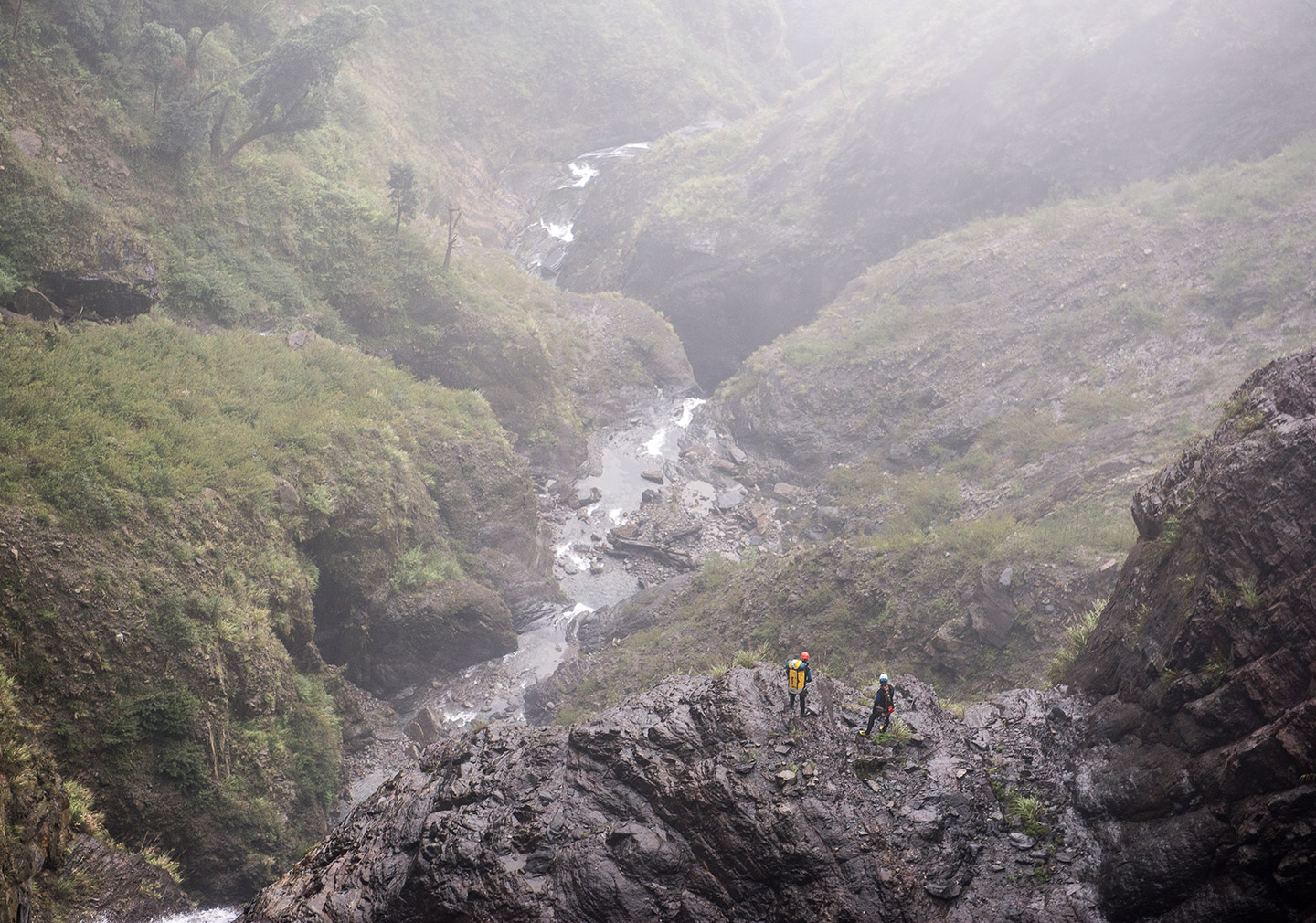
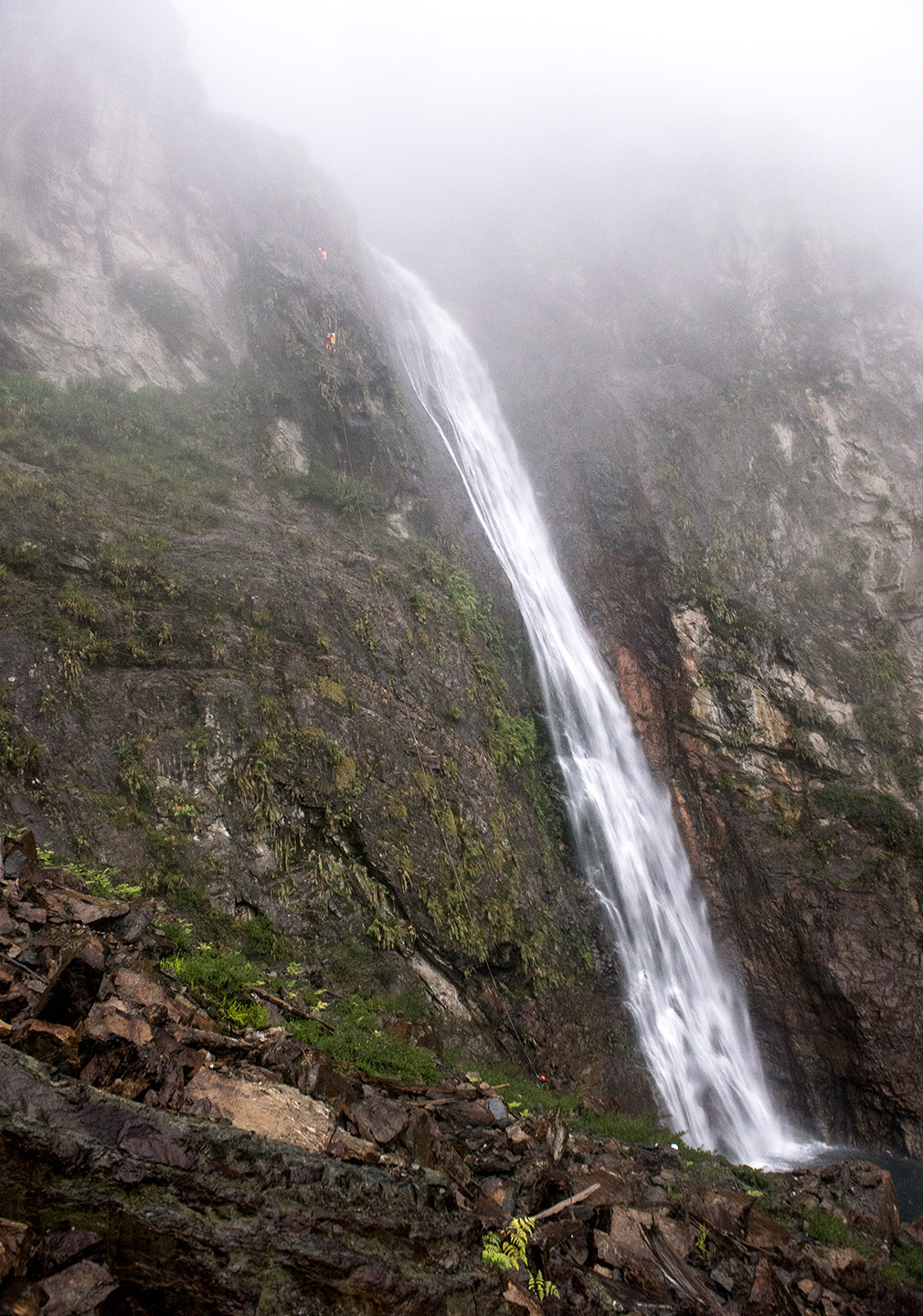

Day 6 awoke with a team resolution to get the heck out of Dodge. We went hard that morning, anticipating multiple drops to negotiate. To our surprise, just two bends downstream, the canyon opened and everything became walkable. We used this much needed break to call out on the Sat Phone to check the weather. Bad news, our Safety Man informed us that there was unfavourable weather moving in for the next two days. We needed to get out of the canyon asap. One final gorge to go, deeper than anything previous, and even more water pushing it to the A6+ level. We decided to get a start on it that afternoon with the hopes it might not be that steep.
The walls shot up over 1000m and the canyon narrowed, focusing the flow. To our amusement, the entry move to the gorge was a perfect 15m jump. I think it was the first time in 6 days that we had laughed out of pleasure rather than hysteria. Soon afterwards, the steepness came and the technicality ramped up. Go time. The team moved fluidly, setting up quickly, managing our packs, and progressing deeper into the gorge… until we met the pool.
The extreme water volume fell roughly 15m into the pool below. It fell down the far right side of the pool, and its strong force swirled the 30m+ pool like a big cauldron. The pool exited on the middle left side, pouring into an open space of unknown height. The walls on the sides of the pool were overhung, preventing us from climbing around. There was no choice but to cross the pool to the other side. The problem was that less than 10% of that strong, white current in the pool poured over the exit. The remaining 90% slammed into the left hand wall – which we would later find was undercut – and it swirled counter-clockwise back around. We decided we would need a guided rappel to get us across, and we elected Akira, our whitewater expert, to swim the rope across.
Once in the pool, Akira entered the swirling current and swam energetically into the strong, white current with his best ferry angle. In all regards, his crossing technique was impeccable in timing and placement, but he didn’t even get close to crossing it. Not dismayed, Akira calmly rode the current around the pool again, building energy and determination to cross it. Once more, not even close. It began to rain grape-like drops into the canyon. After another failed attempt, Akira climbed the rope back up out of the pool. We came up with a new plan: a floating anchor! Maybe we could get the rope bag to ride the current and go out the pool exit. Gus and I set everything up, and we gave the bag our best throw into the current that would likely go over the exit. It soared about 15m and dropped like a sack of potatoes. The current spat it out long before the exit of the pool. We pulled the bag up and tried again, but again it failed. The water discoloured in the canyon and it began to rise. We needed to make another emergency bivvy.
We found a small cavern 20m up from the canyon floor, just big enough to sleep the 8 of us. It was filled with driftwood that made for an excellent flat sleeping surface and dry firewood, but it didn’t inspire confidence since it marked the high water level. We watched from the cavern entrance as the rain continued to fall and the canyon water level rise. We made hot soup and discussed where we were in the canyon and how we were going to cross the pool. Besides the occasional rock falling from the 1000m walls, it was a nice camp.
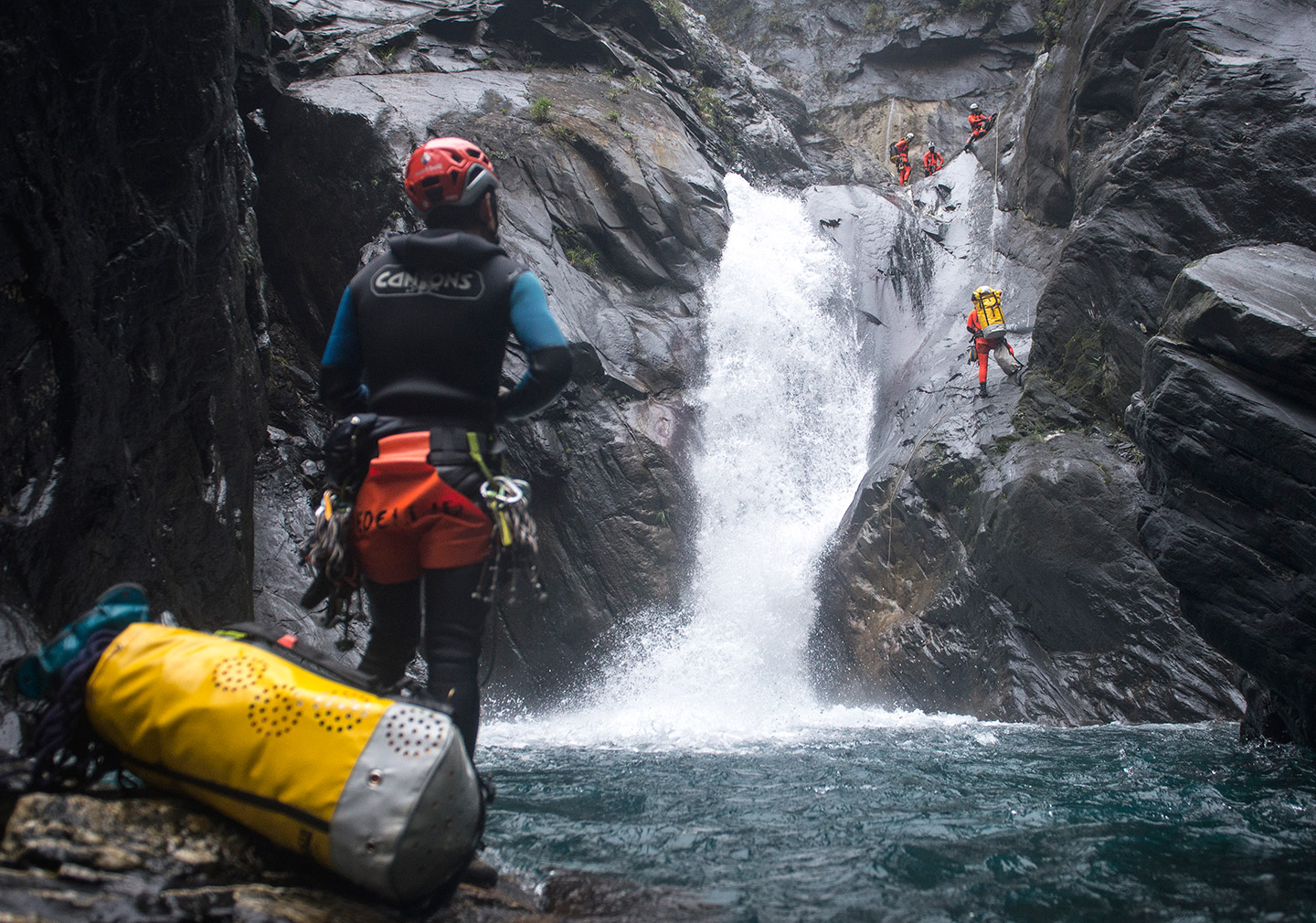
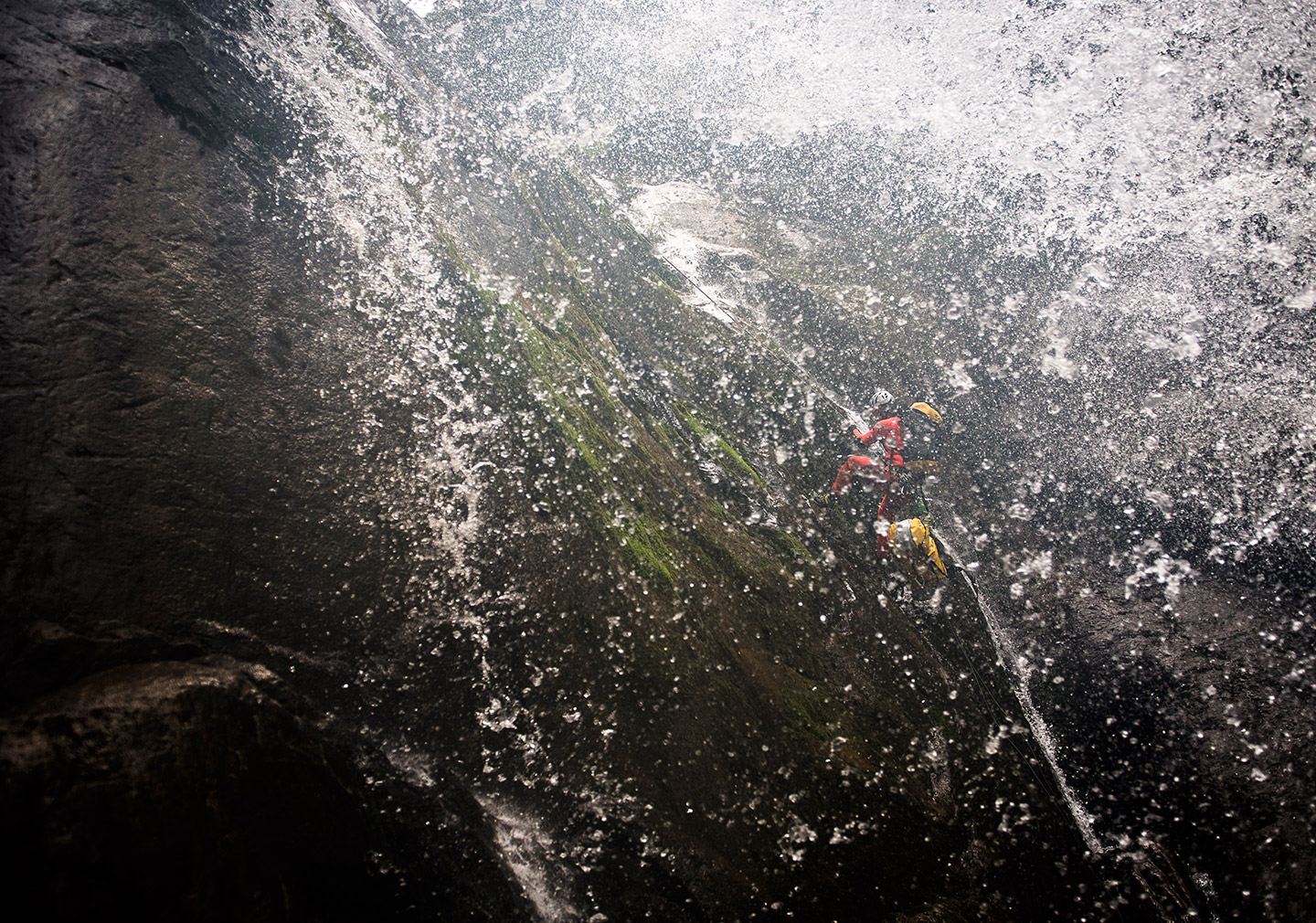
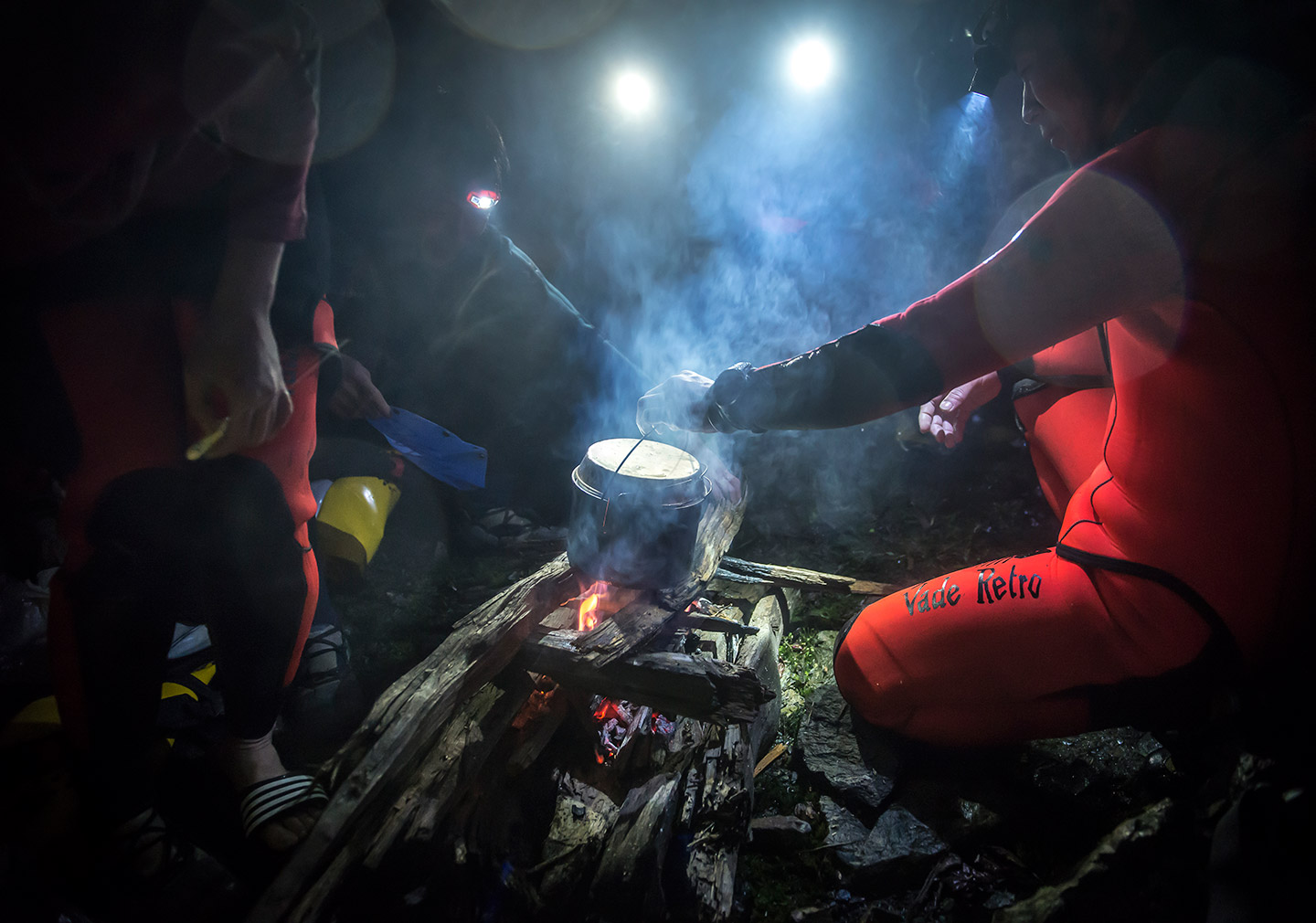
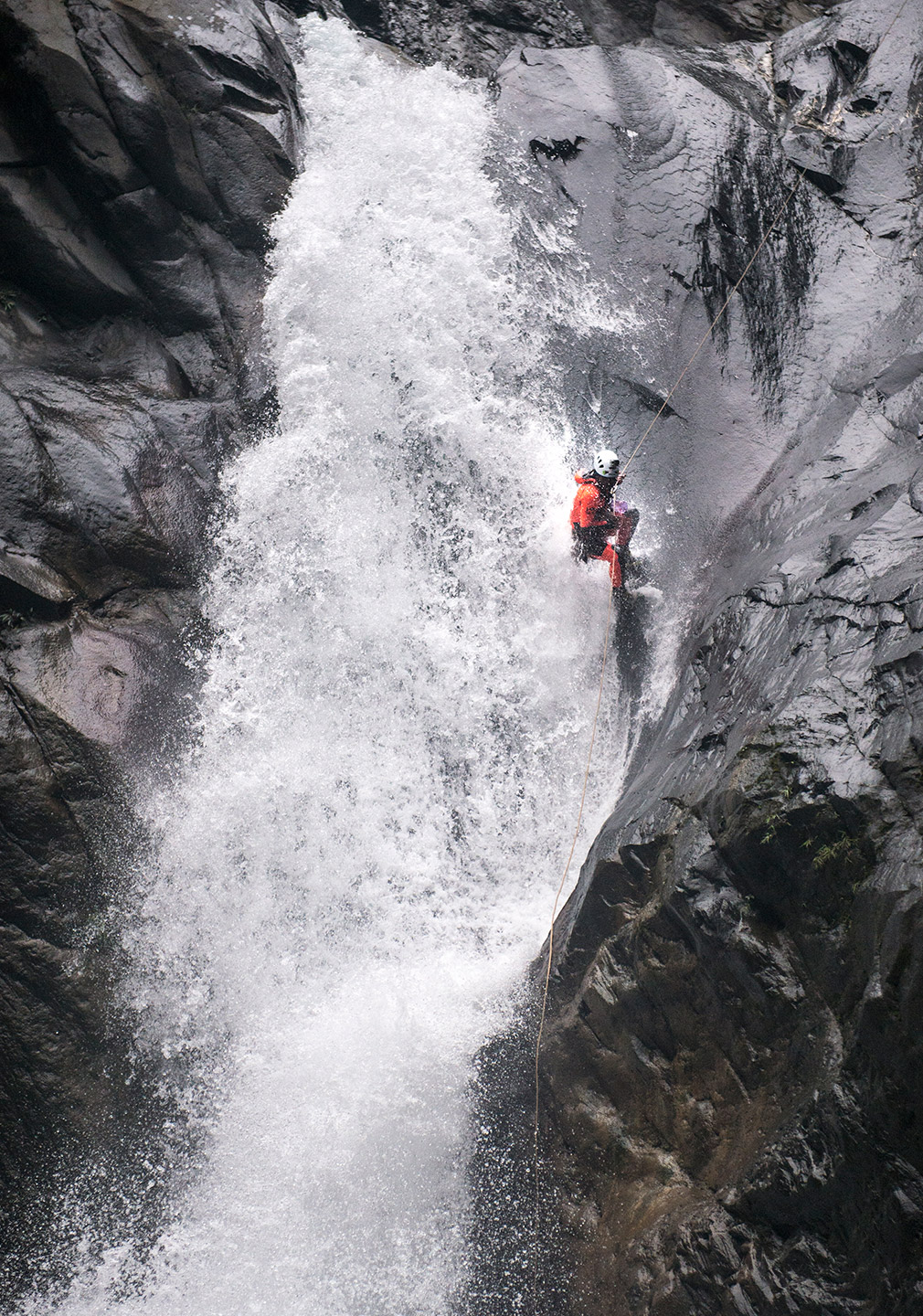
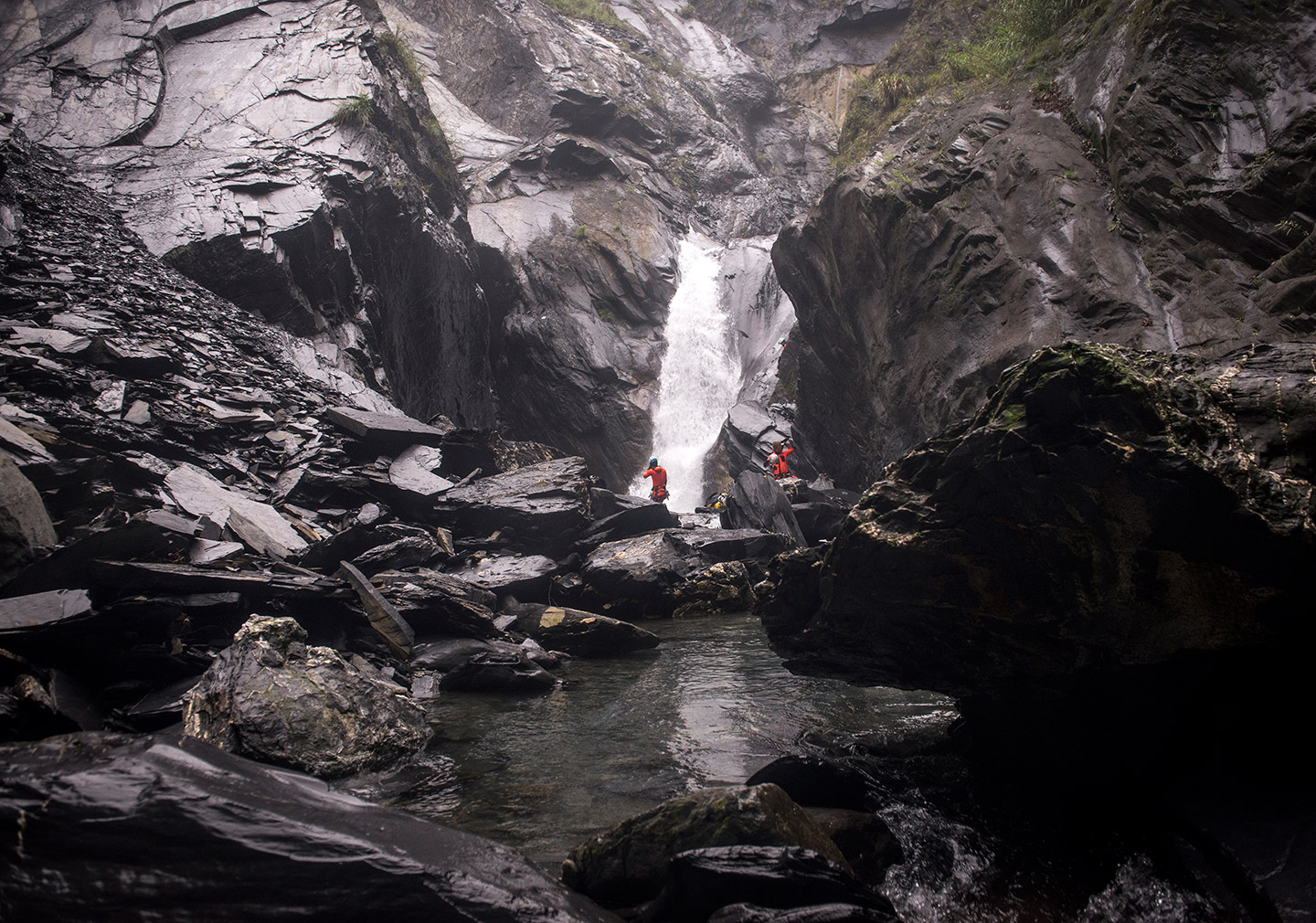
The next morning we found that the rising water had dropped slightly, but it was still higher than when we attempted to cross the pool the day before. Our new plan was to employ two methods of attack. Jasmine Li and Ryoji, our resident Sawanobori, were going to attempt to aid climb the overhung walls to install a handline around it. The rest of us were going to try and make the floating anchor work. Drawing on our training, Gus and I decided to try the double floating anchor technique where you attach a smaller whitewater throwbag to the bigger rope bag. The idea is that you can throw the throwbag a lot farther and more accurately than the rope bag; if the throwbag goes over the pool exit, it will then pull the rope bag over too.
Gus and I set up the double floating anchor technique. Gus would throw the throwbag, while at the same time, I was to throw the rope bag. We counted down from 3, and we gave it all a good toss. Incredibly, the throw bag hit the far pool wall, dropped into the current, and then disappeared over the exit. The rope bag, like the day before, was grabbed by the current and swirled back around the pool. The rope was pulled with it, and the bag disappeared. We waited. Suddenly, like a fish on the line, the rope cut through the water from the left side of the pool toward the exit, and then it tightened. We did it! Now we needed to get someone across on the line.
It started raining again. Akira suited up with all the bolting equipment to rig an anchor on the other side. He attached a cowstail to the guide line, and we attached a second rope to him as a tag line. The water was pumping over the exit, and if Akira lost his footing, we were going to have to pull him back up. Akira rode the guide line down into the pool, where he hit the water roughly half way across. He began to pull himself along the rope into the swift, white current. The current instantly slammed him over to the left wall. We could see him struggle to keep his head above water. “Come on Akira. Come on Akira”, we chanted in unison above. Akira worked his feet to the lip of the wall, laid flat across the water, and balanced himself in the current with his arms. The wall was undercut. He inched slowly along the wall toward the exit. Come on Akira. Once at the exit, he got his feet back underneath him and stood on its edge. The water was waist deep and pushing heavily around him. One slip and we’d have to try and pull him back before he was too far. He creeped steadily toward the right side of the exit where the current would let up on him. Come on Akira. For what seemed like an eternity, Akira finally grabbed hold of the right wall and climbed up on to a small ledge. He stood up on the ledge, raised his arms over his head, and he roared like a lion. The team roared back emotionally. You would have thought we landed a man on the moon.
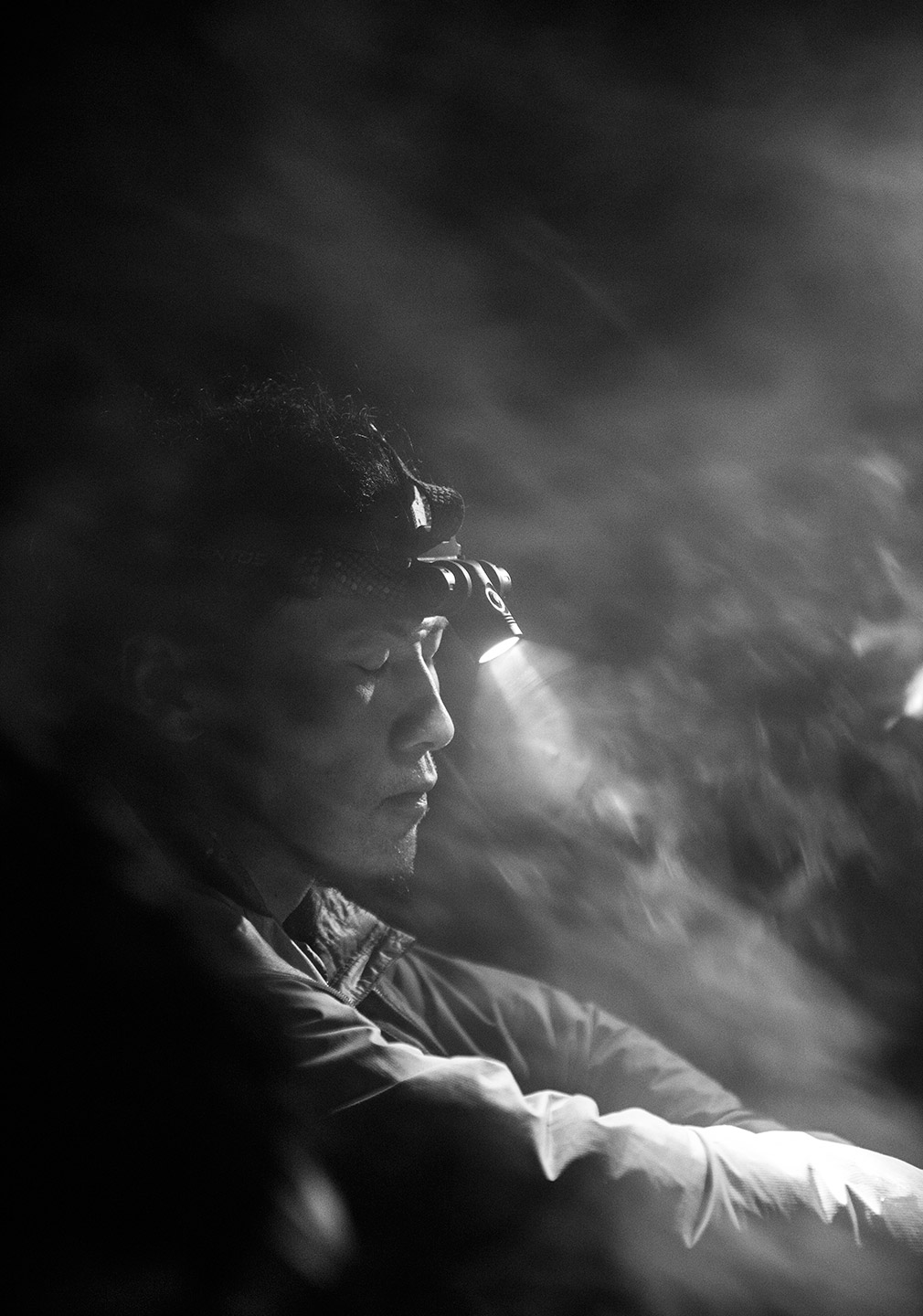
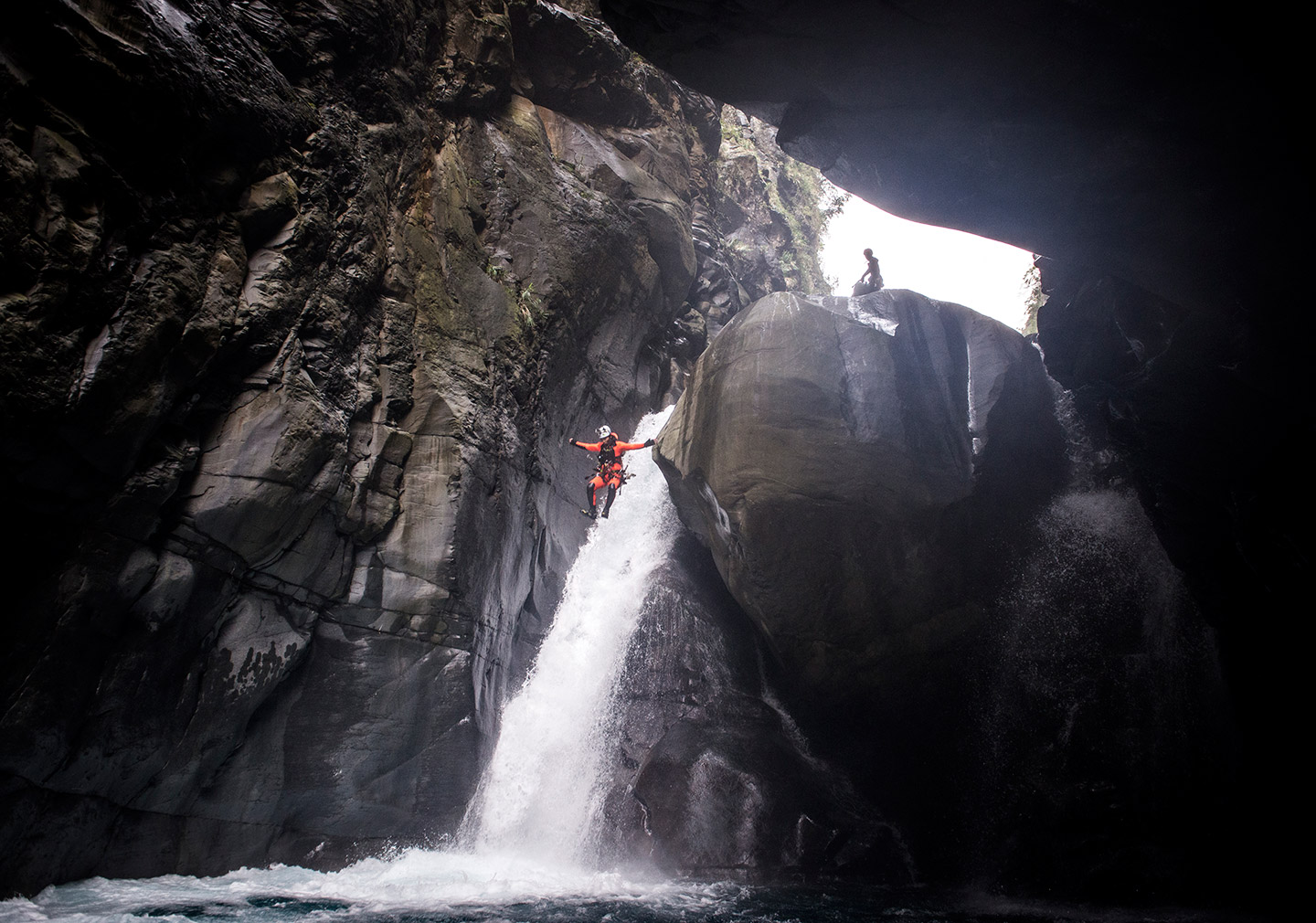
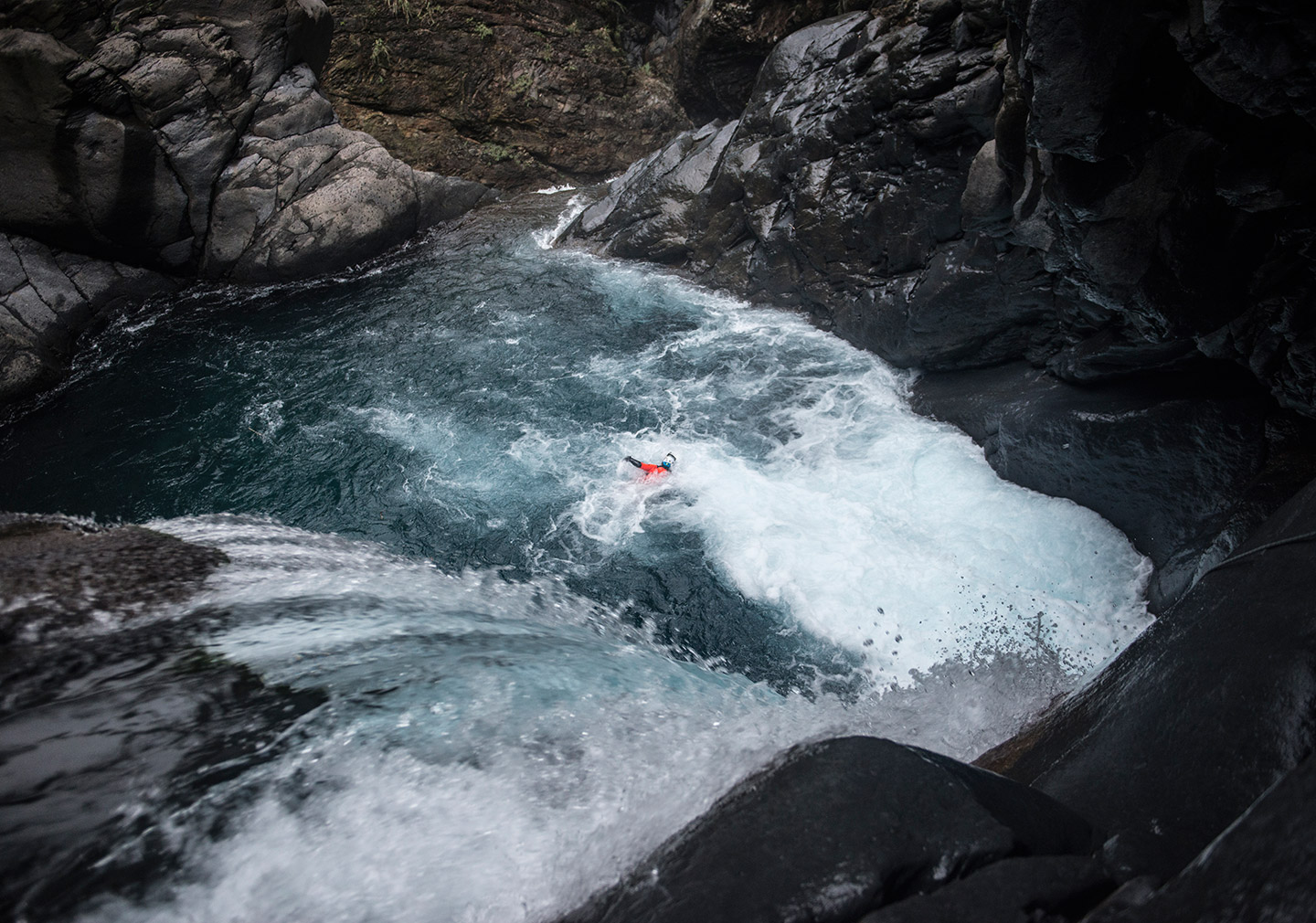
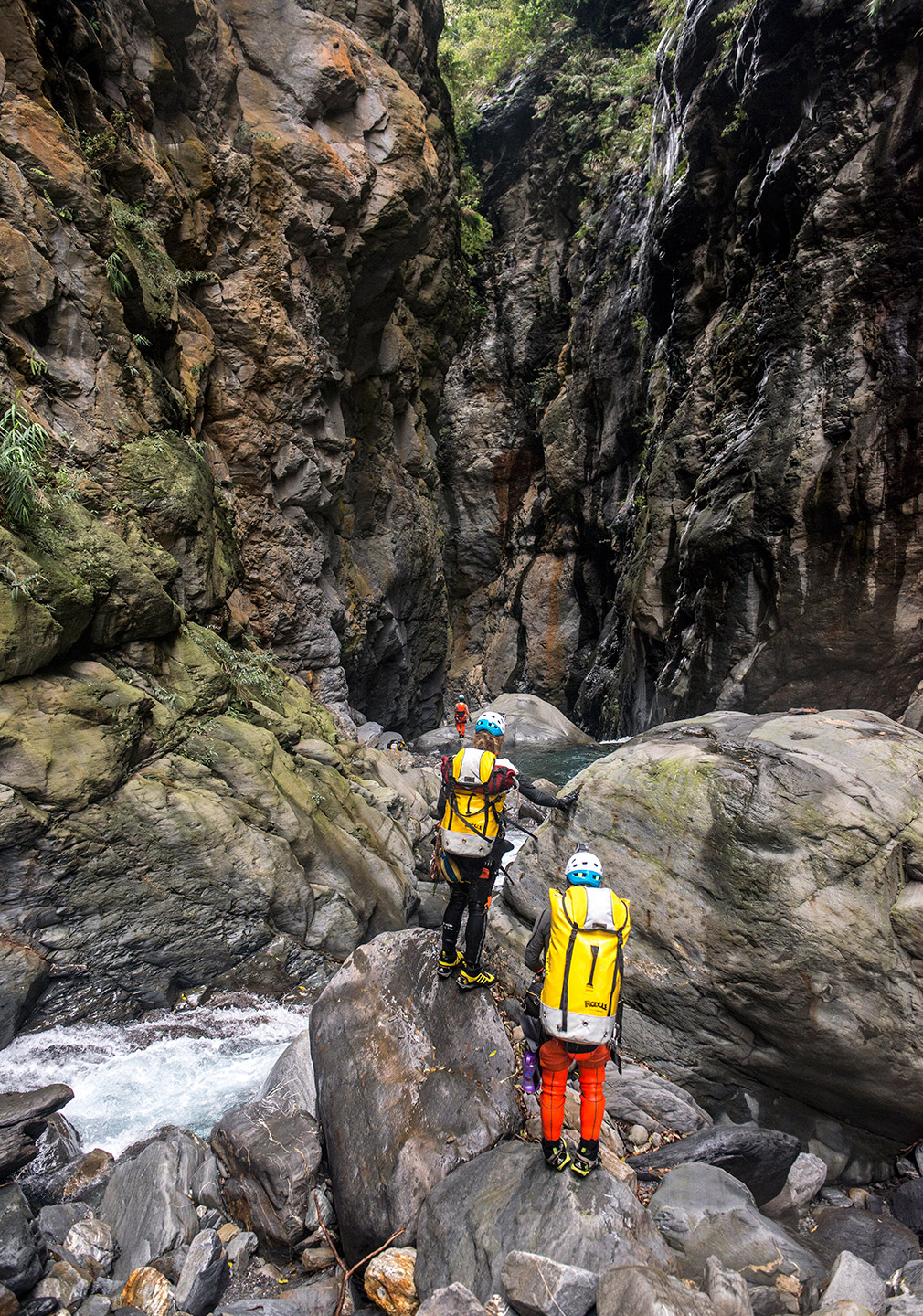
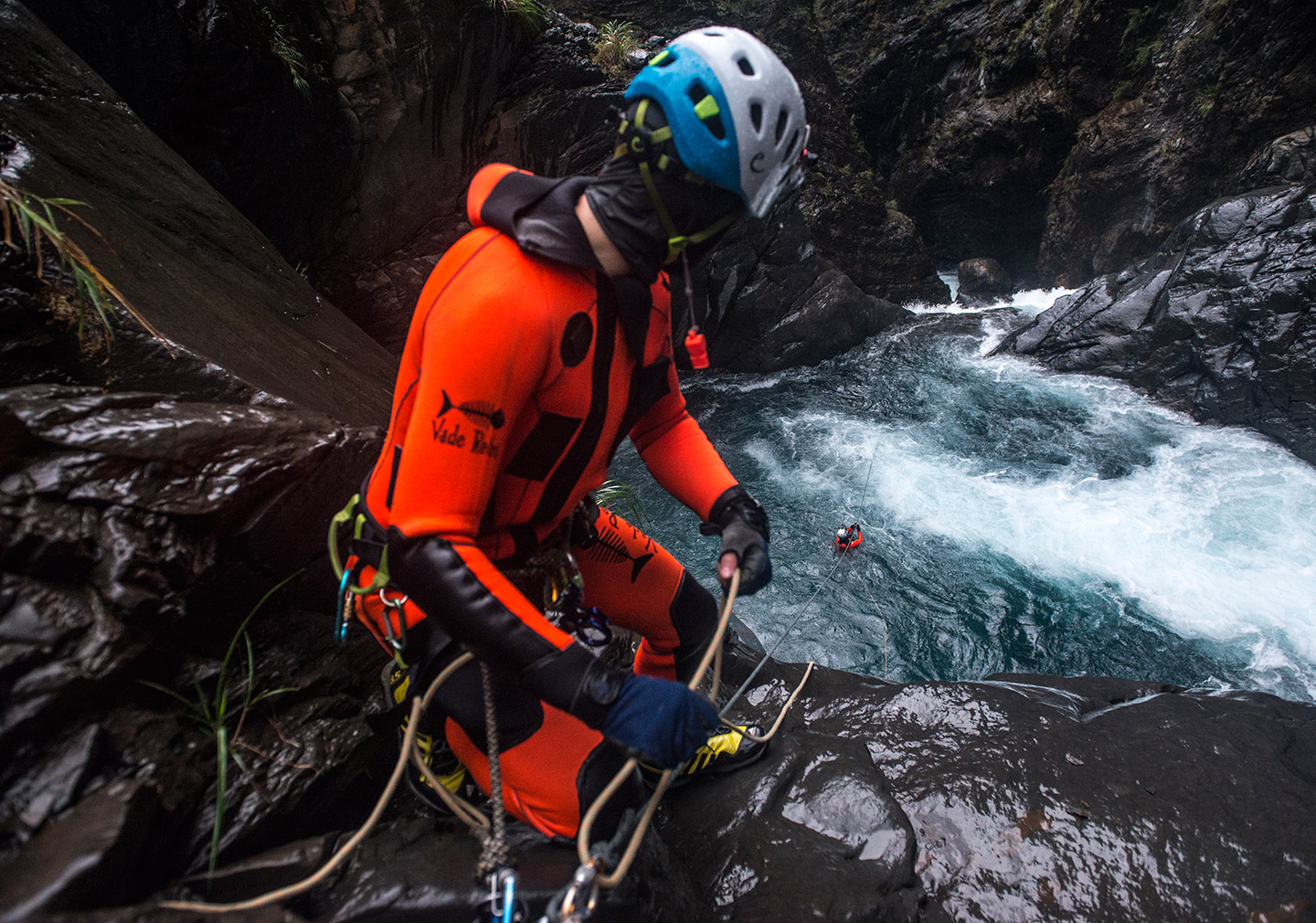
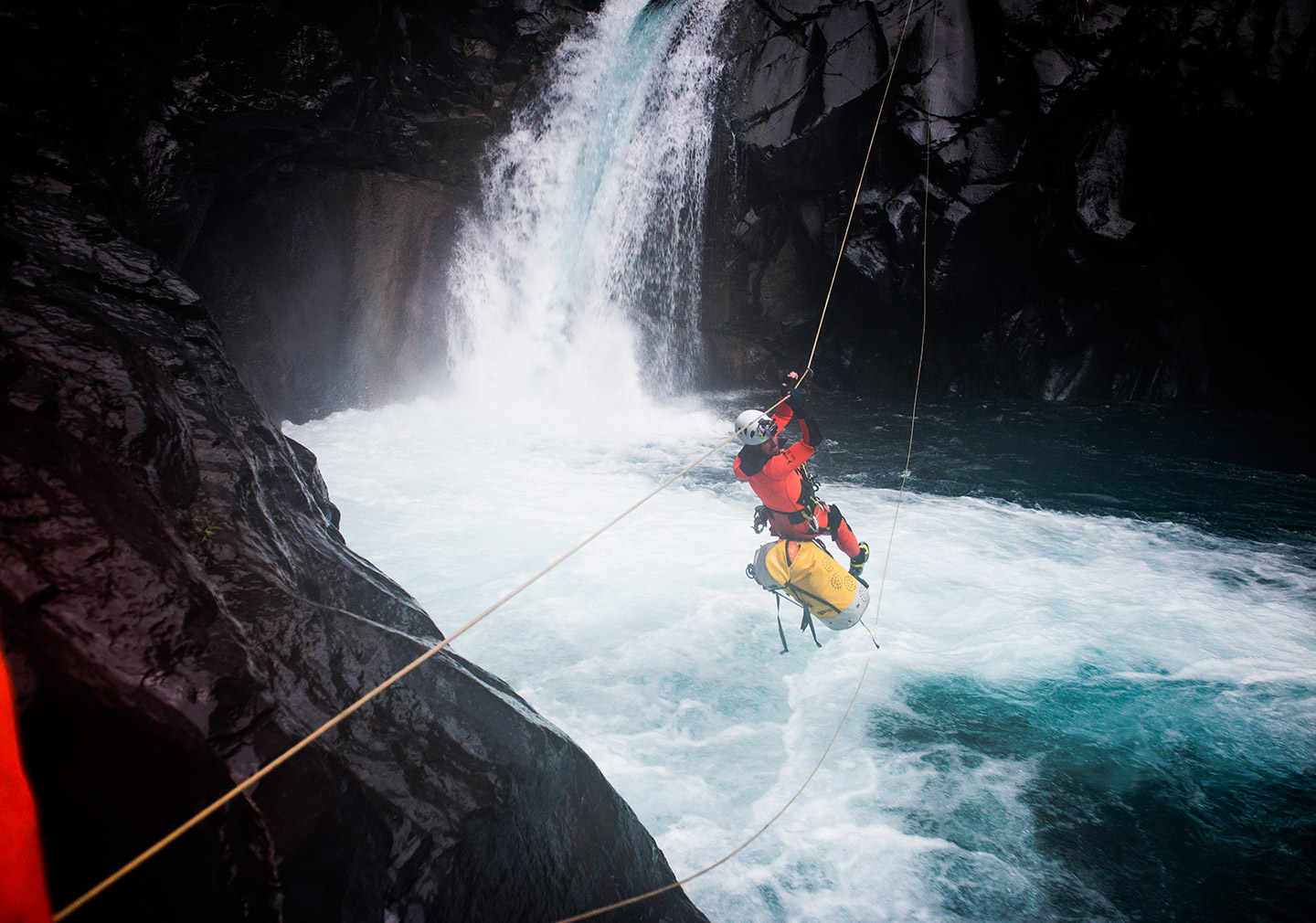
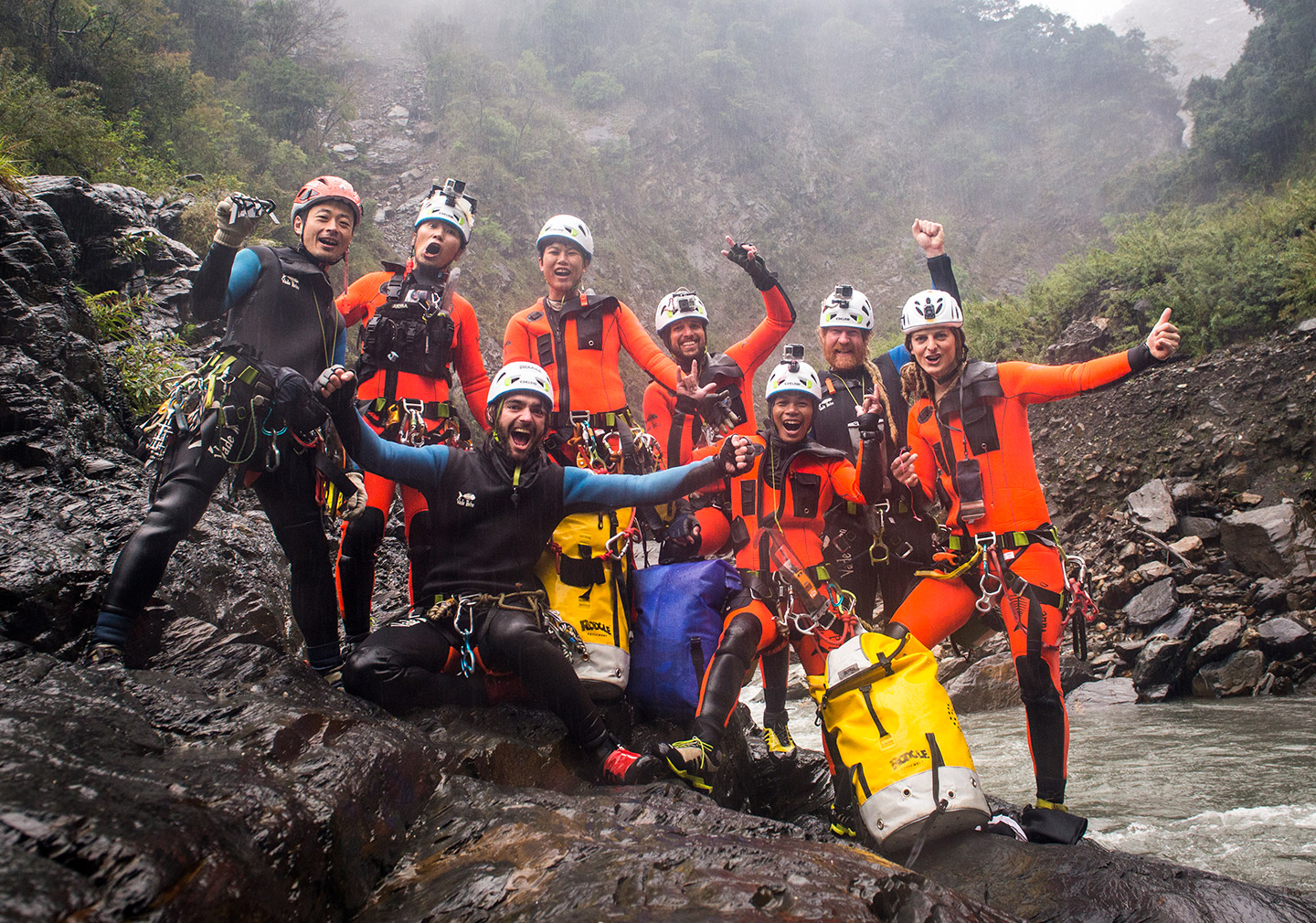
A guide line was set up high across the pool, and each teammate crossed safely above the current. Mike Harris and Akira, with their strong whitewater skills, led the charge down the canyon. The water moved like a river, and we had to cross from side to side using throwbags and guide lines to avoid undercuts, siphons, and hydraulics. It was raining even harder than the day before, and we knew we needed to make it out or we would be caught stranded. The canyon walls slowly opened to more light, lessened in height, and then disappeared. Malishan was finally done. We gathered on the river bank, slapped high fives and gave hugs, then took a group picture. 10 minutes later the Malishan’s water turned mud-brown and the canyon flash flooded. We just made it out.
The hike out was not without peril. As Jasmine always reminded us, “Do not eat all your food until you see the first Seven-Eleven.” The heavy rainfall and recent earthquake had battered the road with unpassable landslides. What should have been a 5 hour walk out turned into 14 hours with incessant bushwhacking, steep cliffs, and advanced route finding. But we were determined not to spend another night in the valley. Besides, there were more canyons to do! At 8pm on Day 8, we were greeted by our driver with hot tea and pastries. 30 minutes later we devoured everything in Seven-Eleven.
